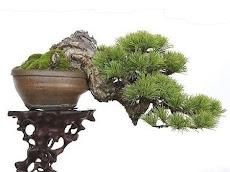Photo by: The Best Garden Design
Ever consider the art of bonsai. Bonsai are not the trees themselves but refer specifically to the process by which to grow and care for the trees. Bonsai is an ancient art, first believed practiced by the Chinese, who shaped their trees into animal forms and then later modified and some say improved by the Japanese.
Bonsai trees are beautiful when grow properly and can make
anyone's garden the envy of friends and neighbors. You will
gain many skills when taking up Bonsai. You will learn new plant
knowledge, pruning skills as well as feeding and caring skills
 Bonsai definitely had its rewards but if you are considering this
Bonsai definitely had its rewards but if you are considering thisor have already purchased your first tree then you should pay
close attention to the advice given in this article. In it will be
some advice for the Bonsai Beginner.
The first piece of advice for the Bonsai beginner is to think this
through very carefully before you go out and buy a forest of
trees. Bonsai can be very rewarding but also very frustrating.
You should first consider the amount of time you have to
devote.
No one is saying that if you work full time you cannot raise
Bonsai. You will have to consider your work commitments, other
interests and see if you can balance everything and still devote
time to your trees. You also need to consider what to do with
the trees when you go on vacation. Just like having a pet.
The next piece of advice for the Bonsai beginner is to know
your own personality. Specifically when it comes to patience
and perseverance. Bonsai are delicate and they do die quite
easily. You may find that your tree is doing fine then all of a
sudden it takes a turn for the worse. This type of thing
happens and you must not let it deter you from trying again.
Sometimes Bonsai seem to die for no apparent reason. You may
have done everything possible to save it and it doesn't help.
This doesn't mean you are the kiss of death. It could mean the
tree had something complex or you just need to practice. By all
means try again. You will eventually get it and reap the
rewards. Learn what killed your tree and take that knowledge
to the next one.
The third piece of advice for the Bonsai beginner is to check
that you have adequate space. These trees do not grow very
fast so unless you live in a shoe box you more than likely have
space for one.. If you want to keep your trees outside then
make sure there are some cool and shady spots to move your
trees into during periods of intense sun or hot dry weather. You
may also want a covered area for periods of heavy rain.
Don't be fooled by the size and delicate nature of these trees.
There is no reason they cannot be kept outside and most
species of Bonsai do better in an outdoor environment. For
 indoor plants make sure you have a fairly large window or a
indoor plants make sure you have a fairly large window or abalcony. Bonsai need light to survive. Be careful not to place
them to close to the window as sunlight passing through glass
is intensified. This will bake your Bonsai.
A forth piece of advice for the Bonsai beginner is to know the
species of your tree. Contrary to popular belief, Bonsai is not a
species of tree but the art. There are many types of Bonsai
trees. Some are deciduous and some are conifers. Knowing you
tree species is vital because you care instructions will vary
according to this. Remember, they are delicate so one mistake
in the care instructions and it could be curtains for your Bonsai.
A final piece of advice for the Bonsai beginner is to start small.
Best to start with one or two trees than a whole forest. Bonsai
trees are not exactly cheap so until you become familiar with
how much care they need keep it simple. It will be easier to
cope, both emotionally and financially from the death of one
Bonsai rather than 12. Hopefully these pieces of advice will
prove helpful to you and your new endeavor. Remember, if at
first you don't succeed then try, try again.
Andrew Perry makes it easy for anyone to grow beautiful, healthy bonsai using the "7 Bonsai Success Secrets". To receive your 6 part bonsai mini course visit:
http://www.easybonsaigarden.com
About the Author
Andrew Perry has spent the last 10 years perfecting the simple bonsai success secrets. Andrew makes the art of bonsai easy and fun for everyone regardless of experience. http://www.easybonsaigarden.com






